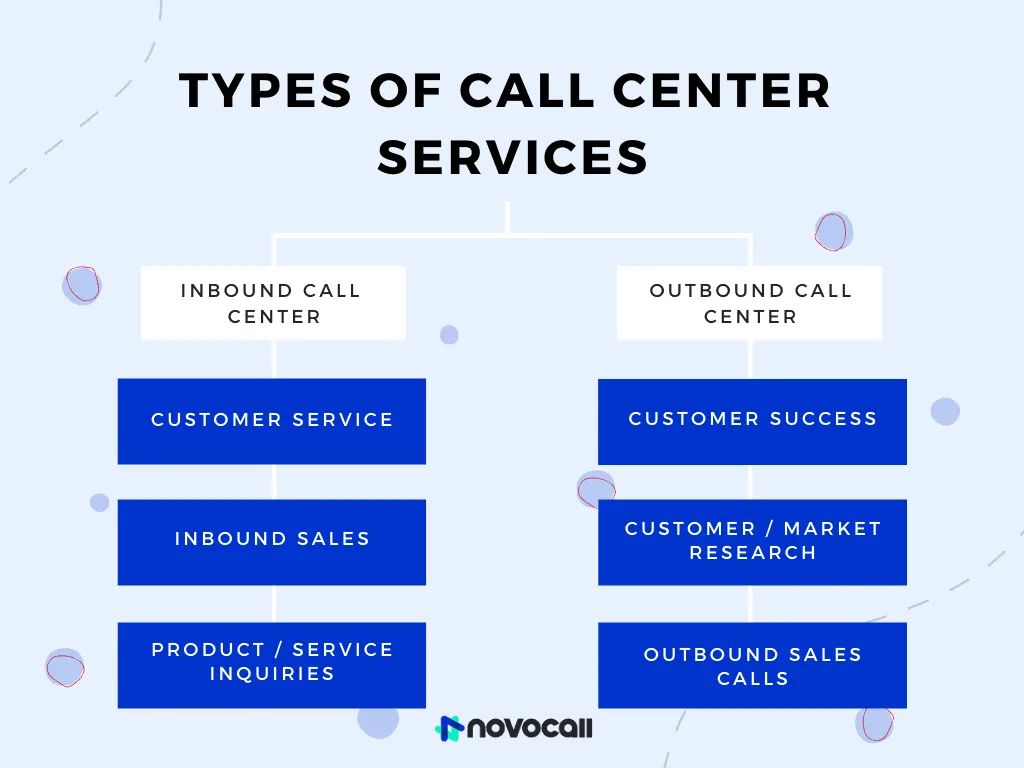

Start driving better conversations.
Novocall will be your new favorite business phone system.

Contrary to popular belief, outbound calls actually work really well! That’s why some industries such as financial services and commercial real estate continue to thrive on it.
Yet “Inbound” seems to be the buzzword these days when it comes to lead generating. And for a good reason too. Inbound strategies have the statistics to boast.
But, are inbound strategies inherently better than outbound strategies?
Let’s closely examine the differences between inbound and outbound call centers and decide if one is truly better than the other.
An inbound call is one that is made to your business by prospects, leads, and customers. They may be interested in your product or service, or just want to find out more about what your company does.
In this case, it may be harder to answer the questions from the caller as you can never be 100% sure of the caller’s profile. Is the caller a marketer or a programmer? Is the caller an executive or manager?
You will need different sales tactics to handle different caller profiles.
Meanwhile, an outbound call is an outgoing call made by your sales rep to a prospect in hopes of converting them.
Unlike the inbound method, your sales reps are making targeted calls. This means that they have plenty of time to do research on a particular prospect profile before making that call.
This gives your sales reps a better understanding of the prospect and may make the sales call a lot easier to handle.
Inbound call centers are typically run by support teams that receive incoming calls from customers. They typically provide customer service to customers with issues or questions.
Meanwhile, outbound call centers make outgoing calls to customers and are run by sales teams cold calling potential customers.
Companies also might make outbound calls to conduct other business activities like survey shoppers and collect market research data.
From success statistics posted on all the different blog articles, it can be easy to see why people think inbound calls are unconditionally better than outbound calls.
That being said, it is important to remember that there is no one-size-fits-all solution. Perhaps these businesses who claim that inbound calls are better in helping them solve their problems were never supposed to have used outbound calls in the first place.
Why else would some industries continue to thrive on outbound calls if it were really that bad?
Let’s take a look at some of the differences between the type of activities each support, and the best software feature that supports each one.

Your customer service team relies on inbound calls to provide assistance to your leads and customers. This can come in the form of product or technical support.
Your leads may want to inquire about certain features of your product, or to understand your pricing plans before deciding on whether or not to make a purchase.
Existing customers, on the other hand, may call in to complain about technical issues they experienced when using your product. They may also be calling in to provide feedback on their user experience.
As mentioned, inbound leads typically find your product by doing their own research.
Your inbound sales team relies on the influx of inbound calls made by these inbound leads to close deals.

Not to be confused with Customer Service, Customer Success (CS) is a proactive approach to gathering customer feedback on your product or service.
In this case, your CS team needs to routinely schedule calls with your existing customers to check in on them to find out if they enjoy using your product or service.
In essence, outbound calls are the only type of calls that can work with your CS team.
Another function of outbound calls is market customer research or data collection.
You might be in a process of developing a new feature or product. Before you launch it, engage in product validation, and obtain certain pieces of information.
Whether or not your intended target audience is interested in your product or service, the best channels to communicate with your target market, as well as the price people are willing to pay.
Some companies set up outbound call centers to make calls to potential customers to see if there is a product-market fit.
In today’s world, if you are not using software to facilitate your operations, you should start right now.
Different types of software have been developed to support both inbound and outbound calls. Each of them come with a suite of features that support inbound and outbound calls. Here is a quick summary table before we delve into the details:

IVR technology is a telephony menu system that allows callers and businesses to use the dial pad for a variety of purposes.
Callers will always receive an automated voice message instructing them to “Press 1 to…” or “Press 3 to…”. This can be used for caller identification, lead distribution, and call distribution.
This helps streamline the communication process as you don’t need to waste time actually asking the callers who they want to speak to. The process is automated.
Call tracking is the process in which your inbound calls are attributed to your marketing campaigns that led the caller to your business.
This provides your marketing team with insights as to which marketing campaign is performing better than the rest. Based on this, you can decide how you wish to redistribute your campaign budget or change your campaign strategy.
When you are managing a large number of contacts to call, you will need an automated dialing system to facilitate the process.
Once the reps’ previous call has ended, the dialer will automatically dial the next number in the queue. Power dialers can also make multiple calls at any one time.
Sometimes, your calls can’t get through. Your prospect’s line may be busy, or the number you dialed was simply disconnected.
When you can’t get through to the numbers you dialed, power dialers move on and dials the next number in line.
Invalid numbers won’t be delivered to reps. This, in turn, maximizes their time on the phone.
Predictive dialers also make automatic outgoing calls and screens out unanswered calls.
What’s different is that predictive dialers have the ability to utilize call metrics to predict the moment when your reps will be available to make the next call.
In other words, if the call center has an influx of calls and many reps are busy, the predictive dialer will slow down or stop its outreach until it detects that reps are nearing the end of their calls.
Larger call centers or companies usually use predictive dialers to help scale the number of live connections.
Your calls aren’t the only things that are categorized based on whether they are inbound or outbound in nature.
Your leads are too! And depending on which classification they fall under, the ease of selling your product or service to them will change.
Inbound leads came to your business because they were looking for a solution to their business problems. This means that they might already have an interest in your product or service before the scheduled call.
Outbound leads, on the other hand, may not know anything about your company and solution at all. Even though research about the prospects is done before calling them, the type of research is generally superficial and serves to see if they fit specific prospect profiles.
For example, research may be done to see if a particular prospect is an executive, manager, or director. Although they fit your target prospect profile, they may not have any interest in your product or service.

Inbound leads tend to be more interested in your product or service because they think that you can potentially help solve their problems.
The fact that your inbound strategy successfully led your leads to your company website and to even schedule a call with you is indicative of their interest. This can make it easier to close deals with inbound leads.
If you are focused on an inbound call strategy, your sales reps take a more passive approach. They do not need to sit by the phone and constantly call your prospects and leads.
Instead, your inbound campaigns will drive leads to them.
This frees up more of their time for you to delegate other tasks to them. The productivity of your sales team will increase overall.
Scripts are often used when making outgoing calls to potential customers because a well-crafted pitch is important to capture the contact’s attention immediately.
Reps also have time to practice and read through their scripts before making the call, instead of being taken aback by incoming calls. This better prepares them to handle the call and manage the call flow.
Because you spend more time doing research to create your ideal prospect lead profile, you have a very clear idea of who you want to target.
All the prospects on the list you will be calling also fit this profile very nicely.
It’s unfair to quickly say that one is inherently better than the other. It’s wrong, almost.
Each type of call center was designed with a very specific purpose and meant to work for very different audiences.
Companies that sell high-value products and services still rely heavily on outbound calls. Meanwhile, those that do not probably don’t use outbound calls as much.
Bottom line is, it really depends.
We hope that we’ve provided you with an insightful comparison of both types of call centers.
While a lot of statistics out there seem to claim that inbound calls are superior, statistics are still numbers at the end of the day. It’s how we derive insights from them that really matters.
If these statistics were derived without taking into account the nature of the business, it’s natural for people to buy into the idea that one type of call is better than the other.
But as we’ve already established, that just isn’t true.
To help you better understand the topic of inbound and outbound lead generation, we’ve prepared a wide variety of resources just for you! Check them out!

Nigel is a Digital Marketing Executive at Novocall where he specializes in SEO. Prior to this, he had written for several SaaS companies including Workstream and the now defunct Hatchme. In his free time, he engages in strength training and is a lover of languages.
Discover more
Subscribe to our blog
Get insights & actionable advice read by thousands of professionals every week.

